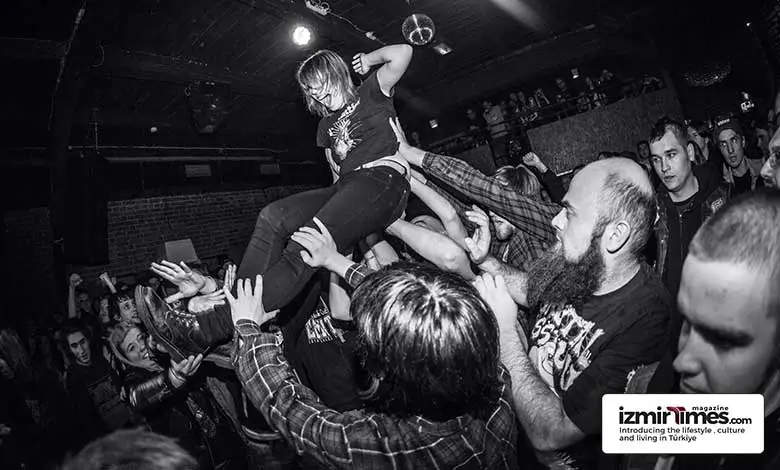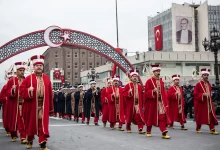
What is punk?
The rise of the punk movement
The economic and social collapse after World War II led to the emergence of the punk movement in the early 70s. Gradual impoverishment of people, unemployment, high cost of living, and conservative policies and media attitudes are among the factors that led to the birth of punk culture.
The anti-authoritarian attitude that started, especially among unemployed or working youth, soon spread to the middle class. And punk is no longer just a philosophical attitude; it has become a subculture and lifestyle.
Where did punk begin?
There are two views that the punk movement originated in London or New York and spread from there. However, in both pictures, the center of punk is seen as London, as the larger audience in the city supports and follows the punk culture.

Punk rock
The starting point of the punk movement is the punk rock music genre, which was created by young people who find the musical infrastructure and classic rock music insincere and fake.
Employing harsh rhythms, more straightforward melodies, and offensive songs, people mostly performed punk rock without musical education, and most of the time, the songs consisted of repeated words, including insults and profanity. Although the punk rock music genre was later divided into many subgenres, it is generally fast, educational, and loud in concerts – especially in the early days of the punk movement to avoid making large and ostentatious stages smaller and closer to the audience. It was being built.
The most famous of the punk rock genre
Black Flag، Anti-Flag، Rancid، Sex Pistols، Green Day، Bad Religion، Minor Threat، The Misfits، Dead Kennedys، The Stooges، The Clash and Ramones.
Punkg clothing style
The punk clothing style also developed as a reflection of alienation from society, rejection, and non-conformity. On the one hand, the followers of punk culture decided to express themselves with everything they had, including their bodies; on the other hand, they argued that appearance was more successful in attracting the attention of others.
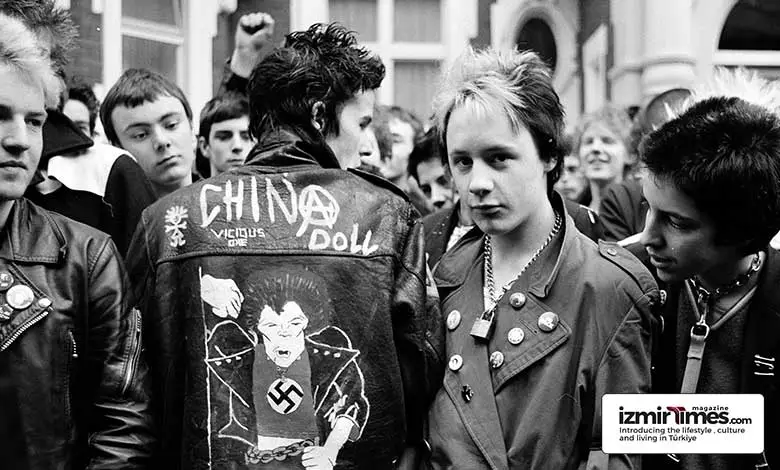
Pins and chains attached to bags and clothes, metal signs sewn on, metal decorations, leather jackets, unconventional sayings written on t-shirts, heavy chains, exaggerated make-up, dyed hair, piercings, and many tattoos that turn the punk clothing style into a kind of anti-fashion and protest.
Anti-consumption and self-sufficiency ethics (DIY)
Born as an anti-capitalist culture opposed to wage slavery, punk rejects consumer culture.
Punks who shop at thrift stores follow a partial barter economy, believing that “if there’s a problem, you have to solve it yourself, don’t wait for someone else to do it,” stealing from flea markets and scavenging. It can also be seen as the other side of the coin.
Punk fanzines (fan letters)
Fanzines, reproduced in black and white on photocopiers and often spliced together, were one of the punks’ most effective means of sharing their thoughts. Fanzines not accepted by bookstores and publishing houses for distribution were sent to readers by mail.
Later, with the widespread use of computers and the Internet, communication became more diverse, and the sharing of documents became easier. The first fanzine that appeared in England in the 70s was Sniffin’ Glue.

The ideology of punk culture
Punks have been involved in many political events since the 70s and have clarified their thoughts and positions. Punk culture stands against the racism, war, hierarchy, and politics. They believe in individualistic and libertarian philosophies.
Thinking that the media is a tool to control people, the slogan of the punks was don’t hate the media, be the media, and the device they used for this was fanzines.
Is there a future for punk culture?!
From politics to racism, from the formal institution of marriage to the understanding of art. Punks used many tools to express themselves and rejected the stereotypes and rules of society. Fanzines, which can be considered independent publications of the punk movement, introduced them. The punks, who surprised people with their actions and appearance, were in some ways like philosophies such as anarchism* and nihilism*. However, their behavior was, in some ways, the opposite of anarchism. They act full of hatred and anger, and their main message is, “There is no future!” Was.
Nihilism or nothingness
Agnosticism is any philosophical view that rejects the existence of an objective basis for the human value system.
In philosophy, nihilism means denying meaning and value to the world’s existence. Nihilism is derived from the Latin word nihil, which means nothing. According to Nietzsche, nihilism or nothingness does not mean valueless values; Rather, it means devaluing values.

Anarchism or authoritarianism
Anarchism or authoritarianism is a political philosophy and movement that opposes the monopolization of power and rejects all forms of coercion and hierarchy. Anarchism wants to eliminate the influence of leadership, and in its opinion, all one-party governments are undesirable, unnecessary, and harmful.
Punk subcultures
• Neo-Nazi punks* who reject nationalist, fascist, and racist policies (Hardline Straight Edge) and respect concepts such as ecology and animal freedom, adhere to religious beliefs, and refuse drugs, alcohol, and premarital sex he does.
• Riot Grrrl opposes sexism and defends LGBT rights.
• Poseur Punk is a group of people who try to get attention by pretending to embrace punk culture.
• Wannabe Punk: Those who claim to be punks at every opportunity to create hierarchy.
• Weekend Punk: Those who live their daily lives within the rules and dress like punks on the weekend.
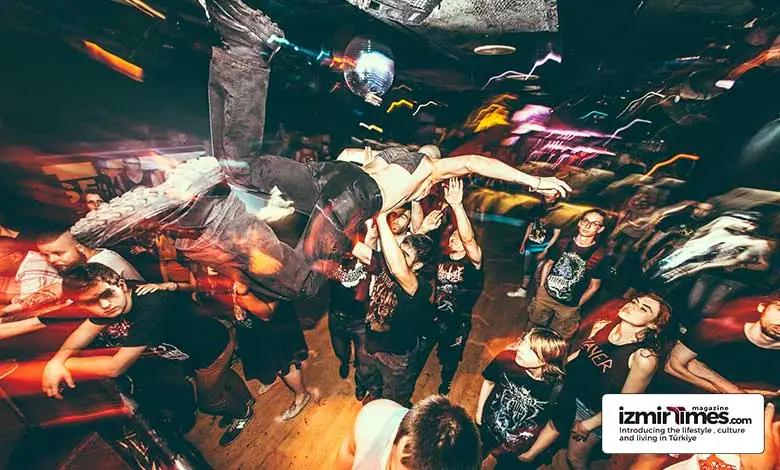
Neo-Nazism
Neo-Nazism refers to post-World War II populations, movements, and ideologies that hold similar beliefs to Nazism. This phenomenon is a global issue seen in many countries and virtual networks. These movements follow signs of Nazi doctrine, such as jingoism, racism, xenophobia, homophobia, anti-Semitism, and anti-communism.
A brief history of hardcore punk music in Türkiye and today’s society
Punk culture in Türkiye
By Mu Tunç
Karl Marx’s suggestion that “art should be a hammer, not a mirror” is invalid for Turkish punk music. Punk music in Türkiye is a window. In this section, we will show this issue gradually.
Today, punk music will continue to live underground as a counterculture, with all its dynamics, even if it has become a profitable product and has been digested and packaged by the fashion system.
By its well-known and accepted encyclopedic definition, Punk is a subversive culture that subverts all the societal values formed around a musical movement in England in the second half of the 70s. It took its musical background from some bands in New York in the mid-70s, and its attitude and style matured in England. The nihilistic and destructive attitude of punk developed over time, and he became an anti-fascist, which is a right-wing political system and a type of extreme nationalist authoritarian government system, anti-capitalist, anti-military, anti-authoritarian, anti-sexist. He has become an anti-homophobe, an ardent environmentalist, and an animal rights advocate.
It was not yet time to listen to punk music.
While the people of Europe and America showed anger towards the punk culture in the second half of the 70s, this culture appeared in street conflicts, strikes, and revolutionary exercises in Turkey. The “traditional” military coup of September 12, 1980, in Turkey was accompanied by torture, imprisonment, execution, exile, prohibition, censorship, and anti-democratic laws. The regime completely silenced the left opposition and intimidated all sections of society, universities, and art circles with systematic depoliticization and depersonalization that continues today. The era of Tonton amca programs, dönmek video tapes and arabesque music.
In such an intimidating and impersonal society, there was a space for a section of young people who did not want to accept the corrupt Arab culture imposed on them and were looking for a place to breathe, and that was heavy metal. They became familiar with heavy metal thanks to the places where they occasionally recorded cassette tapes and were entertained by the pages of two foreign heavy metal magazines. Apart from being magazines, serious metal magazines introduced punk for the majority by transferring the heavy metal music style to punk music.
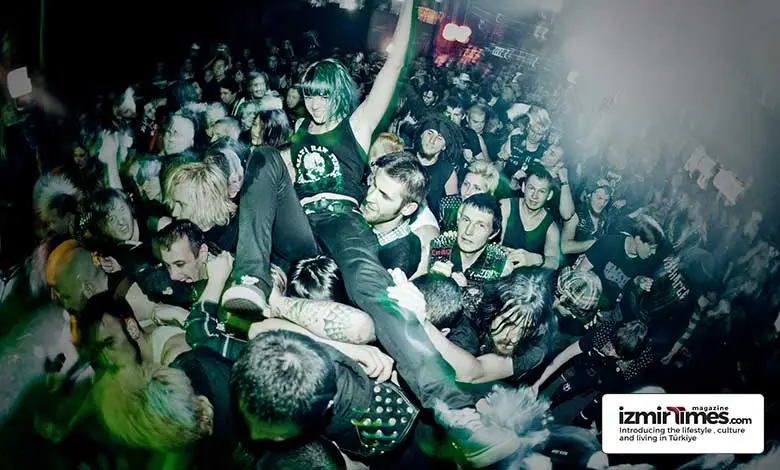
From the second half of the 80s, those who identified as metal or punk began to show themselves in everyday life in Turkey. Shocking tactics of punks against the social order, which started in England in 1977, manifested themselves in Turkey in the second half of the 80s with long hair, earrings, or ripped jeans as a reason for individual freedom. But apart from these street problems, punk could not find a place in everyday life in Turkey, culturally and politically.
In Turkey, according to society’s general customs and traditions, young people could not have a say in any field. Youthful ideas such as belonging to a subculture were never realized due to economic and social pressures, which could only last until a certain age or period (working life, school graduation, military service, or marriage). Therefore, they have yet to create a shared living space or a subculture where they can express themselves.
There were many reasons why punk was integrated with political life in Turkey. The most important of them is undoubtedly the pressure and effects of the 1980 military coup on the general society, the introverted conservative structure of the left, which tried to heal its wounds after the coup and was again looking for a place in social life, and the fact that the punks were generally present in Political life is not a problem.
In Turkish media and society, punk was synonymous with deviance, a kind of hairstyle, neo-Nazi, or Western temptation. There need to be more Turkish sources for reading about punk other than looking at pictures and fanzines, punks’ communication, and information tools, which only appeared after the 90s. For most who describe themselves as punk in Turkey, punk is not more than imitation, just a style of music, a look, and a cover.
This article contains sources from the punk underground from the 80s until 1999, when Rashit’s Telasha Mahal Yok, the first local punk album, was officially released in Turkey. However, this article contains individuals and bands that witnessed that period and should not be taken as a complete collection of punk rock.
When punk music became a well-known and popular youth-subcultural movement in London, continental Europe, and the United States in 1977, writings about punk and rock and roll in general in Turkey at the time were critical. Punk was synonymous with imperialism, Western decadence, corruption, and anti-politics. Critics of punk knew that punk was the agent and guarantor of Western democratic capitalism and could be monetized by the International Fund, even though it appeared to be against it. The leftist movement in Turkey in 1977 was as far from punk as possible, but it was more radical than the most anarchist manifestations of punk. At the same time, punk in Turkey was more international than it could have been. That year, publications published the manifestos of the guerilla movements of the Italian Red Brigades, the Red Army wing of Germany, Iran, Cambodia, and many other countries with the most modern designs. Militants and sympathizers of Albania, China, Cuba, Bulgaria… all countries followed the theory and practice of the left. But straight music was never a hammer, or rather, never a noise production disorder.
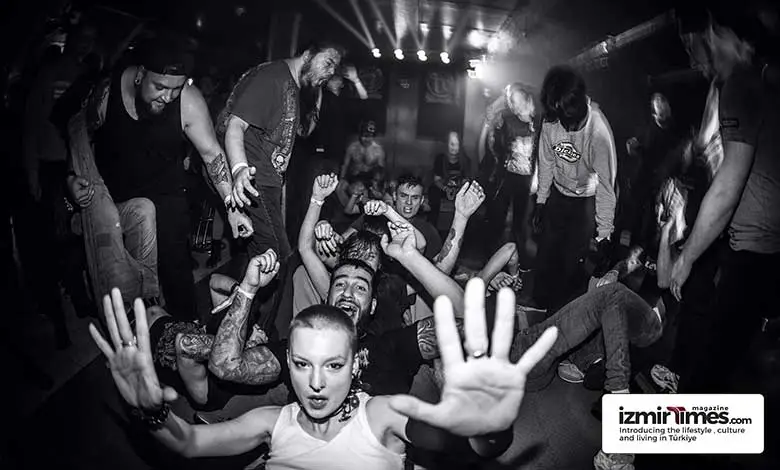
The sad voice of the left, purged of noise, can carry with it a strange conservatism, so if you visit today, the radical political organizations that feed on international theory, like the Autonomists, are the oldest. You see the most boring folklore in the world. Therefore, the analogy between arabesque and punk music made by Murat Belge in the early eighties is fundamentally wrong. Consider punk a more amateurish sound than arabesque high-art music and a revolutionary Vox Populi. We reduce the noisy simplicity on which punk is built to a conservative lament.
Hardcore
Hardcore is a style created in America in the early 80s by punks, but they dress differently than punks and play music much faster than classic punk music to distinguish themselves. Today, hardcore has become a mainstream associated with punk with originality, discipline, and rough lyrics. However, in this article, punk is generally preferred to avoid confusion.
The first place where the word punk appeared in Turkey outside the corners of magazines was the phrase punk rock on the cover of Tünay Akdeniz and Grup Çığrışım’s 1978 album. However, the phrase was more of a commercial punk joke. The first band to actively play punk music was the Headbangers, founded in 1987. 1991 was the year when fanzines, which were punk communication channels, were first seen—the year when the concept of fanzine was born in Türkiye.
Today, although punk has been packaged and turned into a profitable product by domestic capitalism with music and fashion, punk will survive as an oppositional subculture with all its dynamism, underground sharing, and community.
Being a punk in Türkiye
According to the familiar and accepted encyclopedic definition of the term, punk is an antiestablishment and subversive subculture that developed around a musical movement in England in the second half of the 1970s to subvert the values of mainstream society. The roots of punk music can be traced back to some New York bands of the mid-1970s, while its attitude and style came from England. Over time, the nihilistic and subversive attitude of punk matured into a destructive, creative, do-it-yourself, anti-fascist, anti-capitalist, anti-military, anti-authoritarian, anti-sexist, anti-homophobic, deeply ecological, pro-.
In the second half of the 1970s, punk expressed anger in Europe and the United States, while in Turkey, anger emerged in the form of street fights, strikes, and revolutionary exercises. In Türkiye, it was not yet time to listen to music. The “traditional” military coup of September 12, 1980, was accompanied by torture, dungeons, executions, exile, bans, censorship, and anti-democratic laws.
No matter how musically and stylistically punk has been tamed, reshaped, and turned into a profitable packaged product by capitalism, the truth is that punk as an attitude will grow with all its different dynamics. As a dissident subculture, it will live on with its underground soul as long as life lasts.
